Because of its geographical breadth and chronological depth, the Mesolithic is noted for cultural diversity and the emergence of regional territories (Table 1). Nevertheless, the Mesolithic cultures of northern and western Europe shared a number of basic cultural attributes.
The new and rapidly changing environments of postglacial Europe required an adaptive shift to take advantage of the expanding resource base. Mesolithic hunter-gatherers exploited a wide range of medium-sized ungulate species that flourished in the forests, including red deer, roe deer, elk, aurochs, boar, sheep, goat, and ibex. Small animals provided food and fur; birds, fish, shellfish, and marine mammals were heavily utilized at some sites. Coastal sites were often accompanied by large shell middens. For the first time, plant resources became an important part of the diet, including species such as hazelnuts, acorns, European water chestnuts, and nettles.
Mesolithic hunter-gatherers managed the landscape. Chipped and ground stone axes were used to
Cut down trees, and the controlled burning of swamps and wetlands provided open land where animals could congregate for easier hunting. In northern and western Europe, the dog was domesticated during the Mesolithic, perhaps to assist with hunting by tracking wounded prey or flushing birds and small game (see Hunter-Gatherers, Ancient).
By the Late Mesolithic, a well-developed ‘collector’ economy based on resource intensification was in place throughout northern and western Europe. Plant and animal resources were extensively exploited based on their reliable and recurrent seasonal availability, producing a surplus that could be stored for later use. For this reason, several anthropologists and archaeologists have argued that some Late Mesolithic foragers should be considered complex hunter-gatherers.
Technology
Mesolithic stone-tool technology was based on microliths - small stone tools, usually geometric in shape, that were manufactured on small blades or bladelets. They were set into special slots in bone or antler shafts, forming a composite tool (Figure 1). Composite tools were used both for hunting and procuring and processing plant materials. Organic tools were manufactured of bone, antler, or wood, and included a variety of harpoons, bird points, and fishing equipment such as fish hooks and leisters (Figure 2). Nets and seines were used to ensnare large numbers of smaller fish.
Axes of chipped and ground stone were also used for woodworking (Figure 3). Wood was an important
Figure 1 (a) Reconstructed Mesolithic composite point with microlithic inserts; some composite points had as many as 11 microliths inserted into a prepared groove, (b) a triangular geometric microlith or triangle.
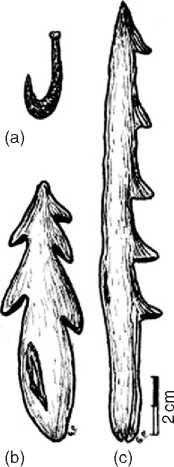
Figure 2 Mesolithic organic tools: (a) bone fish hook, (b) Azilian antler harpoon, and (c) Mesolithic barbed antler point.
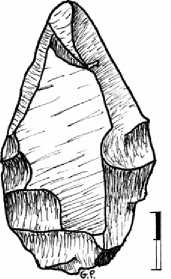
2 cm
Figure 3 Mesolithic flaked stone ax.
Resource in the Mesolithic, and it was used to construct dwellings and to manufacture boats, canoes, and paddles. The earliest evidence of substantial carpentry dates from the Early Mesolithic of Star Carr, where a wooden platform or track was constructed over the boggy terrain between the site and the nearby lake; the earliest known dugout canoe comes from Pesse in the Netherlands.
The first definitive evidence of the bow and arrow in Europe dates from the Mesolithic, and wood was used for Mesolithic self bows and arrow shafts. The bow and arrow was an important advancement in hunting technology. It was useful in a wide range of environmental settings, including postglacial forests, and it allowed hunters to kill from a greater distance and with more accurate targeting. Transverse arrow
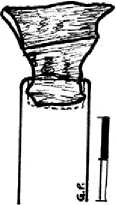
2 cm
Figure 4 Mesolithic transverse arrow point.
Points were added to the tool kit later in the Mesolithic; they relied on a straight cutting edge to produce a wide wound channel (Figure 4). The discovery of a number of Mesolithic composite and transverse points lodged in the bones of game animals confirms their effectiveness as hunting weapons.
Pottery and ground stone tools, considered hallmarks of the succeeding Neolithic stage, made their first appearance in the Late Mesolithic. Ground stone was used to make axes and adzes, as well as beads and figurines. Although never abundant, pottery was present in several Late Mesolithic cultures, including the Campignian of northern France and the Erteb0lle of southern Scandinavia. Mesolithic pottery was utilitarian and was used for cooking and food storage. Erteb0lle vessels had thick walls and little or no decoration, and the most common form had a pointed base. Small oval ceramic bowls may have been used as lamps.
Settlement
The Mesolithic pattern of resource diversification and resource intensification encouraged population mobility, and Mesolithic hunter-gatherers moved regularly in an annual cycle called a seasonal round, taking advantage of plants and animals during their peak abundance. For this reason, it is necessary to examine regional settlement systems rather than individual sites. In southern Scandinavia, for example, large sites, such as Bj0rnsholm and Smakkerup Huse, were located along the coast, with smaller satellite settlements, such as Ringkloster, located further inland for specialized activities such as hunting, trapping, or freshwater fishing.
Larger coastal sites often had a longer duration of habitation. Many of these larger settlements were semisedentary or sedentary, and some, such as Erteb0lle and other Scandinavian sites, were probably occupied year round. Domestic structures were variable in form: round, semicircular, oval, or rectangular. Houses had sunken floors, wooden post construction, and a single central hearth, suggesting that they were occupied by a single family or small group.
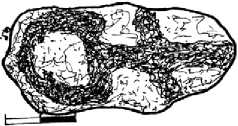
Figure 5 A typical Azilian painted pebble.
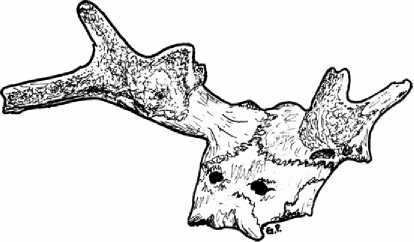
Figure 6 Artist’s rendering of the red deer antler headdress from Star Carr.
Art and Ritual
The Mesolithic was characterized by a decrease in artistic quality and quantity, especially in comparison to the preceding Upper Palaeolithic. Largely schematic rather than naturalistic, Mesolithic art was produced in a restricted range of colors - the reddish hues of ochre, complemented by black and white. Enigmatic objects such as Azilian painted pebbles may have been a form of artistic expression, although they could have been lunar notations or even game markers (Figure 5). Jewelry and items of personal adornment were present in the Mesolithic, including ground stone beads, pierced shells and teeth, and amber, and the presence of exotic items indicated regional exchange and interaction. At Star Carr, 21 red deer antler headdresses were probably worn for ceremonial rituals or used as hunting disguises (Figure 6).
The existence of numerous Mesolithic cemeteries confirms the existence of burial rituals. Although most Mesolithic cemeteries were small, they provide a great deal of information about the culture and biology of Mesolithic populations. Burial techniques were not yet standardized. At the large cemeteries of Skateholm I and II in Sweden, both inhumation and cremation were practiced, and the unusual ‘skull nests’ of Ofnet, Bavaria, suggest either ritual veneration or large-scale violence. Many graves, including those of children, were colored with ochre and accompanied by grave goods, including tools, jewelry, shells, and animal and human figures, suggesting the emergence of a social status based on age and gender differences. Physical anthropologists have determined That the health status of Mesolithic populations was good, with little evidence for disease or malnutrition. Numerous traumatic injuries, however, indicate that violence was a common cause of death, and mass graves, like the one at Strpby Egede in Denmark, suggest intergroup conflict.




 World History
World History









